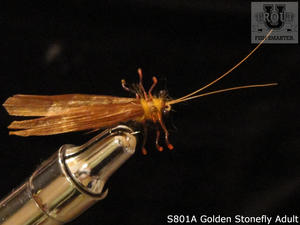
The characteristics of the stoneflies are that they have two claws at the end of each leg and two sets of wing pads. They have two short, heavy tails, two antennae and the have the appearance of being "armor plated."
Stoneflies represent a big portion of the trout’s diet in the Smokies where there are species of all nine families of stoneflies. The most important species with the biggest populations of stoneflies present in the Smokies is the Periodidae whose size and shape vary only slightly.
The Little Yellow Stoneflies are of the Perlodidae species. Some streams in the Smokies have very significant populations of the Little Yellow Stoneflies and the nymphs live in riffles and rocky runs with moderate to fast flows. When there is no hatch taking place, the stoneflies are relatively safe from being eaten unless they are knocked loose. When that happens, which is not frequently, a nymph pattern can be productive when dead-drifted through riffles and runs.
Like almost all other stoneflies, at maturity, the nymphs migrate from their normal locations down in between and under rocks on the streambed to the slower water and then to the banks to hatch. Just as soon as they get out of water, they shed their shucks and fly away. The Little Yellow Stonefly hatch usually occurs during the daytime, especially near dusk, but can also occur later in the warm summer evenings. These times of migration to hatch provide the angler an excellent nymph fishing opportunity.
The streams in the Smokies are usually small and overgrown, but if conditions allow it, cast from the bank. But be sure to use care as you walk along the bank because the trout can “hear” you through the water using their lateral line. If you do get in the water, wade away from the bank about 6 or 8 feet and fish the nymph down and across allowing the nymph to swing back to the bank. This will work much better than an up stream cast. Cast out ten or fifteen feet using a reach cast that ends with your rod pointing towards mid-stream. Then slowly swing the rod back in the opposite direction pointing it towards the bank swinging the fly all the way to the bank. This will cover 20 or 30 feet of water with each cast. Attempt to keep the fly at least 20 feet away from you if possible unless the water is real shallow as is often the case in the Smokies, then it may be necessary to keep the fly even farther away.
The most important thing to remember is to weight the fly to get it on the bottom as it will not be effective if it is in the middle or top of the current. Pick the rod up ever so slightly allowing the fly to swing toward the bank for a few inches. Then repeat the process, but only after the fly hits the bottom of the stream.
In addition to the Little Yellow species there are many different species of stoneflies in the streams of the Smokies, so from late winter until early fall there may be a hatch occurring. For that reason, a stonefly nymph pattern is a good bet anytime during those months.





